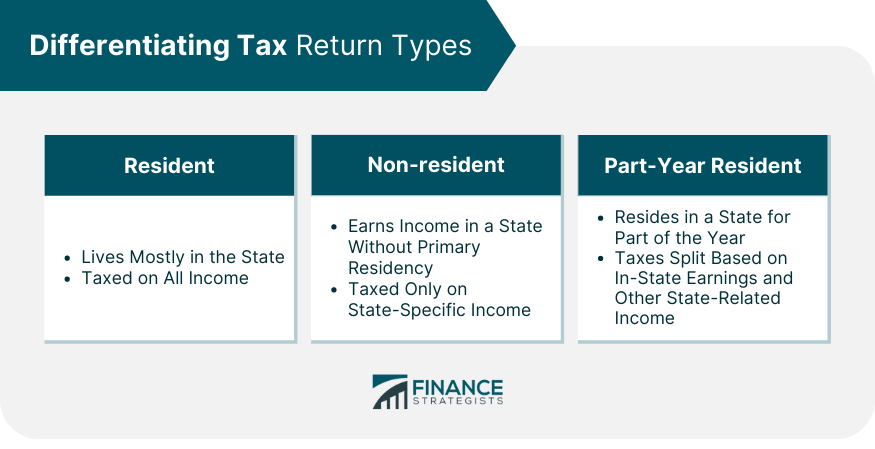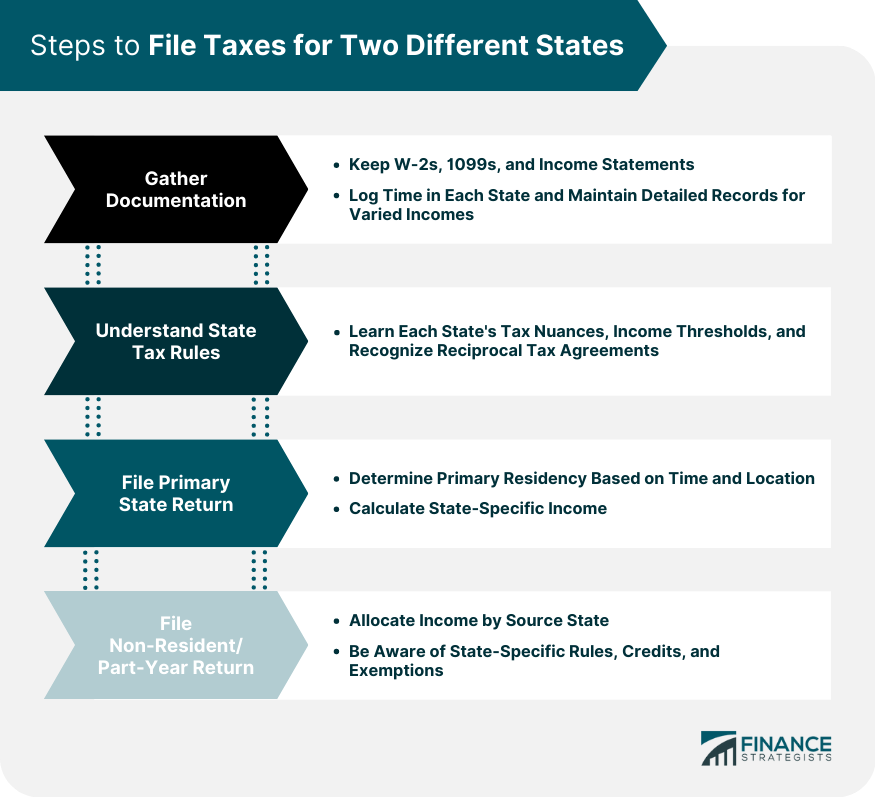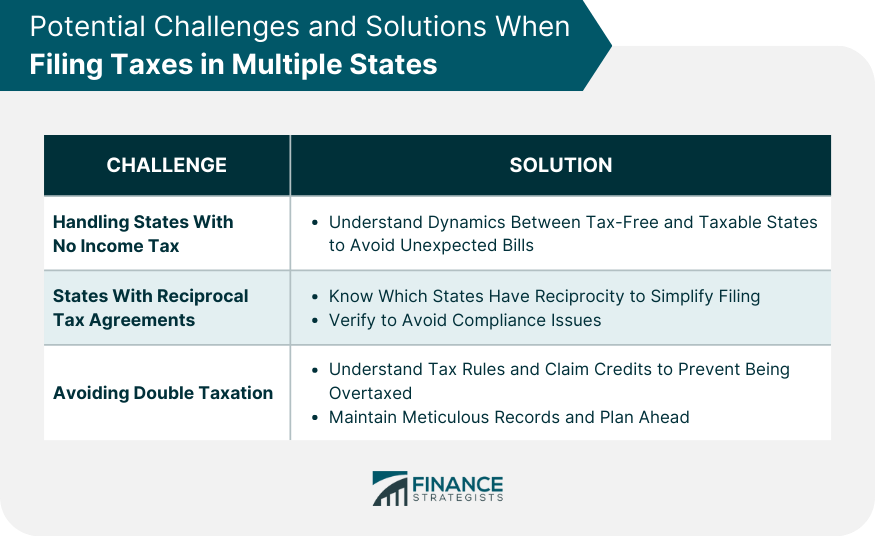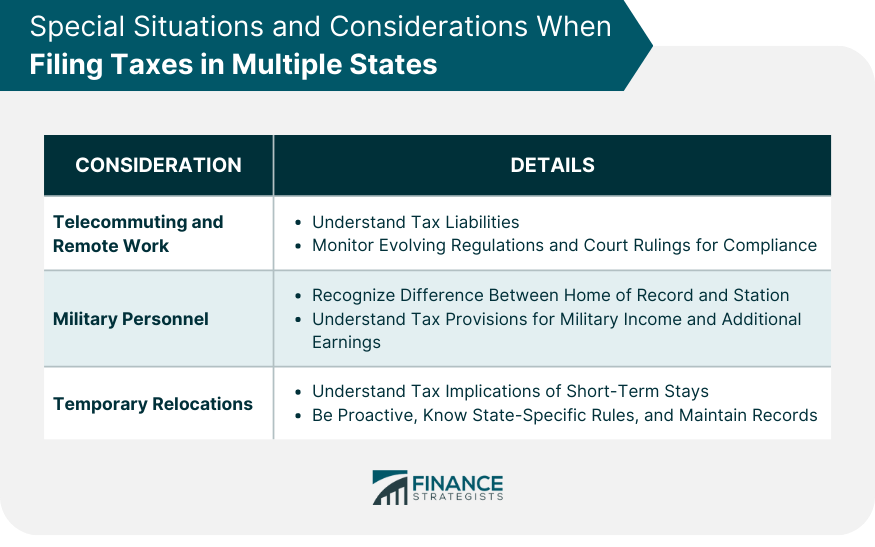Filing taxes in two different states adds layers of complexity to an already intricate process. With varying regulations, tax rates, and definitions of income, understanding the nuances of each state's tax system becomes essential. For many, managing tax obligations in multiple states can feel like navigating a maze without a map, fraught with potential missteps at every turn. Taxpayers may find themselves engaged with diverse forms, deadlines, and tax codes. Whether it's deciphering different income brackets, reconciling conflicting state policies, or optimizing deductions across states, the challenges are manifold. Yet, with careful planning and understanding, it's possible to simplify the process and ensure accurate filing. Accurate multi-state tax filing is crucial to avoid overpayments, penalties, and fines. Proper filing ensures taxpayers pay precisely what they owe, offering financial and mental peace. By staying updated with changing tax codes and state rules, one minimizes audit risks, ensuring more confident financial choices. Working in One State and Living in Another: A common reason many individuals face dual tax obligations is due to employment in one state and residence in another. This is frequently seen in metropolitan regions spanning multiple state borders. Relocation During the Tax Year: Moving between states within a tax year necessitates multi-state filing. Such relocations might be prompted by job changes, familial commitments, or personal lifestyle choices. Owning Businesses or Rental Properties in Different States: Diversifying assets by owning businesses or rental properties across state lines can create intricate tax situations. Each source of income becomes liable to its specific state's tax regulations. Residents are individuals who live in a state for the majority of the year. They usually have significant ties, such as a home or family, in that state. As residents, they're required to pay state taxes on all their income, regardless of where it was earned. Non-residents earn income in a state without living there predominantly. They are only taxed on the income they earn within that specific state. For example, someone who lives in State A but works occasionally in State B would file a non-resident tax return for State B. Part-year residents have lived in a state for only part of the tax year. This could be due to moving in or out of the state. Their tax obligation will be split based on the income they earned while living in that state and any other state-related income during their non-resident period. Effective multi-state tax filing starts with diligent record-keeping. Documents such as W-2s, 1099s, and other income statements form the foundation of any tax return. In multi-state scenarios, ensuring that each income source is clearly tied to a specific state is paramount. In addition to income statements, taxpayers should maintain clear logs of their time spent in each state. This can be crucial in determining residency status, especially for part-year residents. Those with more diversified income sources, like rental or business income, should also have detailed records to determine the state-specific income and associated expenses. Each state has its idiosyncratic tax landscape. Delving into these rules can sometimes feel like decoding a foreign language, but it's an essential step. Knowledge about state-specific income thresholds, for instance, can guide taxpayers on whether they need to file in a particular state. Reciprocal tax agreements further add to the complexity. These are arrangements between states that prevent double taxation for mutual residents. Recognizing if such agreements exist between the states, a taxpayer is involved with can save time, effort, and money. Establishing a primary resident state is pivotal in multi-state tax filing. This designation impacts how income is reported and how taxes are calculated. To determine primary residency, one often looks at factors like where the taxpayer spent most of the year, where their primary residence is located, or where they intend to stay indefinitely. Once the primary state is identified, taxpayers should focus on calculating all income earned during their residency. This process may involve prorating certain income types or excluding income sourced from other states based on specific state rules. Outside of the primary resident state, taxpayers may need to file non-resident or part-year resident returns in other states. Here, the focus shifts to allocating income to the respective state based on where it was earned or sourced. Filing these returns requires a nuanced understanding of each state's rules. For instance, some states might only tax specific types of income for non-residents. Others may offer credits or exemptions to minimize the risk of double taxation. By familiarizing oneself with these nuances, taxpayers can ensure they're not overpaying or underreporting. Tax credits can significantly reduce a taxpayer's liability, and their availability often varies by state. In a multi-state scenario, taxpayers should be proactive in identifying and claiming credits they're eligible for in each state. Whether it's credits for education, energy efficiency, or child care, understanding what's on the table can yield tangible financial benefits. However, while these credits are beneficial, ensuring they are only claimed in the appropriate state is crucial to avoid potential compliance issues. Just as tax rates and credits vary, so do deductions. States often have their definitions of what qualifies as a deductible expense. In multi-state scenarios, understanding these differences becomes paramount. For instance, while federal tax laws might allow a specific deduction, a state might disallow it. Conversely, some states might offer deductions not available at the federal level. Thus, taxpayers should not assume uniformity and should tailor their deductions to each state's specific rules. Walking the tightrope of multi-state tax filing, one of the riskiest maneuvers is claiming the same credits or deductions in multiple states. Doing so, either inadvertently or intentionally, can lead to complications, including potential audits or penalties. While the allure of reducing tax liabilities is strong, it's crucial to understand the rules in play. Often, states offer credits for taxes paid to other states to alleviate this burden. However, ensuring that deductions are prorated or allocated correctly can help taxpayers steer clear of potential pitfalls. Claiming benefits across states is a nuanced process. There's a lurking risk of claiming double benefits, where taxpayers might inadvertently enjoy tax advantages in both states. Additionally, clawbacks, where states retract previously granted benefits due to non-compliance or changes in circumstances, are real threats. To navigate this challenging landscape, taxpayers should remain informed and proactive. Engaging in strategic tax planning, staying abreast of changing laws, and seeking expert advice when needed can make the difference between a seamless tax experience and a challenging one. A handful of states in the U.S. have opted not to levy a personal income tax. At first glance, earning income in such a state might seem like a tax haven. However, complications arise when taxpayers reside in a taxable state but earn income in a tax-free one. Such scenarios demand careful tax planning. While the income might not be taxed in the state it was earned, the resident state may still seek its share. Being proactive and understanding these dynamics is key to avoiding unexpected tax bills. Reciprocal tax agreements are lifelines for many taxpayers, but they come with their set of challenges. These agreements typically allow residents of one state to earn income in another without being double-taxed. However, it's essential to be aware of which states have such agreements in place and how they operate. By doing so, taxpayers can avoid the cumbersome process of filing returns in multiple states. Instead, they may only need to report the income on their resident state return. But, always be cautious, as assuming reciprocity without verification can lead to compliance issues. One of the gravest concerns in multi-state tax scenarios is the specter of double taxation. This occurs when the same income is taxed by two different states. While many states have mechanisms to prevent this, the onus often falls on the taxpayer to ensure they're not overtaxed. Navigating these waters requires a keen understanding of both states' tax rules. Often, taxpayers can claim credits in their resident state for taxes paid to another, thus mitigating the risk of double taxation. However, meticulous record-keeping and proactive planning are vital to ensure one doesn't end up overpaying. The rise of remote work has brought forth a new set of tax challenges. When working from home in one state for an employer based in another, understanding tax obligations becomes crucial. While the convenience of remote work is undeniable, it might blur the lines of state tax liabilities. Typically, states tax income based on where it's earned. However, remote work complicates this definition. Some states may claim the right to tax based on the employer's location, while others might look at the employee's residence. Keeping abreast of evolving regulations and court rulings in this space is essential to ensure compliance. Members of the military face a unique set of challenges when it comes to state taxes. For starters, their state of legal residency (home of record) might differ from where they are stationed. This duality can lead to confusion about where to file and what income to report. Thankfully, there are provisions in place to ease this burden. For instance, military pay is often only taxable in the home of the record state. However, other forms of income, like from a second job, may be subject to taxation in the state of the station. Familiarizing oneself with these nuances can help military members and their families avoid tax pitfalls. Temporary moves, whether for a short-term job assignment, extended travel, or family reasons, can muddy the tax waters. While the relocation might be temporary, the tax implications can be lasting. A few months' stay in a different state might necessitate filing a part-year resident return there. Factors like the duration of stay, intent, and nature of income earned during the relocation play into the tax equation. While a brief stay might not trigger tax obligations, longer durations could. Being proactive, understanding state-specific rules, and keeping clear records can help taxpayers manage these transient tax situations. Filing taxes in multiple states is a complex endeavor that requires nuanced understanding and diligent record-keeping. With varying regulations, tax rates, and definitions of income, the intricacies of state-specific tax systems pose potential challenges for taxpayers. Common reasons for multi-state tax obligations include employment in one state and residence in another, relocation during the tax year, or diversified assets across states. A clear distinction must be made between resident, non-resident, and part-year resident tax returns, with each carrying its own implications. Effective tax filing for multiple states begins with gathering appropriate documentation, understanding state-specific rules, and avoiding pitfalls like double taxation. In today's landscape, considerations also extend to remote work, military personnel, and temporary relocations. To navigate this multifaceted tax terrain, staying updated with changing tax codes, seeking expert advice, and proactive planning are paramount, ensuring accurate filings and financial peace of mind.Overview of Filing Taxes in Multiple States
Understanding the Need to File in Two States
Reasons for Multi-State Filings
Differentiating Tax Return Types
Resident Tax Returns
Non-Resident Tax Returns
Part-Year Resident Tax Returns

Steps to File Taxes for Two Different States
Gather Necessary Documentation
Understand State-Specific Tax Rules
File the Primary Resident State Return
File the Non-Resident or Part-Year Resident Return

Understanding Tax Credits and Deductions in Multi-State Filings
Identifying Available Tax Credits in Each State
Differences in Standard and Itemized Deductions for Each State
Implications of Claiming Credits or Deductions in Both States
Avoiding Pitfalls: Ensuring No Double-Benefits and Understanding Clawbacks
Potential Challenges and Solutions When Filing Taxes in Multiple States
Handling States With No Income Tax
Addressing States With Reciprocal Tax Agreements
Avoiding Double Taxation on the Same Income

Special Situations and Considerations When Filing Taxes in Multiple States
Telecommuting and Remote Work Considerations
Military Personnel Considerations
Temporary Relocations

Bottom Line
How to File Taxes for Two Different States FAQs
Individuals may need to file in multiple states due to working in one state and living in another, relocating, or owning properties/businesses across states.
States classify taxpayers as residents, non-residents, or part-year residents based on duration, intent, and other criteria.
Remote work complicates tax filing, as some states tax based on the employer's location, while others consider the employee's residence.
Military members might deal with differing tax obligations due to their home of record and their actual stationed location.
Each state has unique tax credits and deductions, so taxpayers must tailor their claims to specific state rules to ensure compliance.
True Tamplin is a published author, public speaker, CEO of UpDigital, and founder of Finance Strategists.
True is a Certified Educator in Personal Finance (CEPF®), author of The Handy Financial Ratios Guide, a member of the Society for Advancing Business Editing and Writing, contributes to his financial education site, Finance Strategists, and has spoken to various financial communities such as the CFA Institute, as well as university students like his Alma mater, Biola University, where he received a bachelor of science in business and data analytics.
To learn more about True, visit his personal website or view his author profiles on Amazon, Nasdaq and Forbes.











